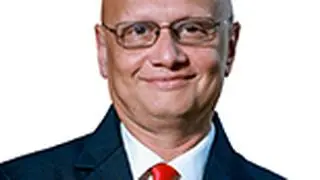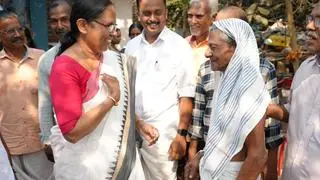Giving cheap and reliable electricity without creating any turf wars between the producing and consuming States is a challenge before RK Singh, Minister of State (Independent Charge) for Power and Renewable Energy. Singh, a bureaucrat-turned politicians, has set stiff deadlines for his team to meet the targets, including electrification of all remaining inhabited un-electrified villages by this month end, connection to all willing households by December 2018 and infrastructure for seamless power by March 2019. Singh is also focussing on cleaning up the State distribution utilities’ balance-sheets. In an interview with BusinessLine , Singh said “the States and UTs have resolved to clear all current year’s dues of Discoms along with 25 per cent of arrears so that entire old dues are paid by March 2019.” Excerpts:
Power tariffs have been a bone of contention between producers-suppliers and buyers. Will there be further reforms in Tariff Policy with particular reference to cross subsidy?
Rationalising of cross subsidy is not actually a new reform. It was envisaged in the Tariff Policy itself. Section 61 of the Electricity Act mandates that cross subsidy will be brought down and eliminated. The Tariff Policy takes it from there and specifies that cross subsidy should not be more than 20 per cent. But, the fact is that it is not being implemented. We are going to ensure that it is implemented.
But States have their own norms for electricity (State subject) …
It is not. Electricity is in the Concurrent List and this means that both the Centre and States can make laws. The law made by the Centre holds. Besides, any law passed by the States which is in contravention to the Centre can apply only when they have taken the Presidential assent. Despite this, we want to take the States along. As you saw, we consult them.
We understand that the government is seriously considering use of DBT for power – shifting support from the Discoms to the consumer…
Policy decisions regarding subsidies are taken by the State governments. We are saying that if you want to give subsidy, you give it directly to the consumers’ account. This allows a clearer accounting and Discoms cannot hide their inefficiency behind the subsidised sector.
Right now if you ask Discoms about their losses, they will point to the agricultural sector, and it acts as an alibi to hide their inefficiencies. Besides, once DBT is introduced, the consumer behaviour will also change. Right now it doesn’t make a difference to the consumer if the pump keeps running for seven or eight hours. When you credit that benefit into the account and tell him to pay the bill, then he will watch his consumption.
You give him say ₹500 or ₹1,000 under DBT and tell him that this is for the agricultural power and whatever he saves in consumption is his money, then he will try to limit his consumption to below ₹1,000.
Who exactly is the individual user who will be getting the subsidy through DBT…
The agricultural sector means the farmers who use power for irrigation (like electrical pumps). So suppose the State says that for irrigation, electricity will be available at ₹1 a unit. Then they will calculate the farmer’s per acre consumption of power in irrigation. The difference between what the Discom is allowed to charge and actual cost of supply is the subsidy. This amount will be credited to the accounts through DBT after paying for power consumed.
But, how will you decide the beneficiary? Will you fix the subsidy amount? Would the Centre be supporting it?
Who gets the DBT depends on the States. Some have a policy that offers free power for agriculture. There is cross subsidy which is going to be reduced to 20 per cent. The basic sphere where a flat rate is charged or where power is free is the agricultural sector. As regards amount, it will again depend on the States. No Centre support is required.
How do you propose to reduce the existing tariff slabs?
Currently, we have a ridiculous situation where there are about 80-90 power tariff slabs. There are different slabs for each sector like agricultural, industrial and consumer. What we can do is create one or two categories in each sector. Like for households we can have a category where a household consuming less than 100 units you can have a slab which is 20 per cent less than the supply cost. The next is neutral category, where the tariff is as per the supply cost. And then there is a third category where the tariff is 20 per cent more than supply cost.
In fact, all States have agreed to bring down losses to 15 per cent or less by January 2019, after which the losses will be capped at this percentage.
Is the tariff of renewable energy being artificially suppressed? Do you see this as a reason for wind energy segment taking a hit?
This perception is incorrect. The tariffs have been discovered through open bidding.
Regarding wind projects, the problem is coming from manufacturers, who are saying that they are forced to sell equipment after leaving a margin of 15 per cent for the developer. And that they (the manufacturers) are left with a tariff of only about ₹2.15 a unit leading to companies either benching manpower or selling products at a less. We don’t want the industry to make a loss, we want them to survive.
We need 60 GW of wind power by 2022. As per the demand trajectory, we are going to offer no less than 10,000 MW of wind projects every year. The wind equipment manufacturing capacity of the country is 6000 MW, and imports are not a substitute. So there will be no year when equipment supply in the country will not be stressed and the industry will not have to sell at a loss.
You say players take commercial decisions. This is a similar to what gas-based projects faced. Situation doesn’t seem to have changed…
Imported gas is no longer viable. Who will buy gas based power if it produces electricity at ₹6 a unit, when electricity on the exchange is available at ₹3 to ₹4 a unit?
Then what is the way out…
As far as gas is concerned, their time will come. The Ministry of Petroleum and Natural Gas is thinking of pooling gas for power plants. If they pool domestic and imported gas, then the prices will come somewhere in between and become near viable.
And we are going for time of day tariffs, so peaking tariff will be different. When we are going in for injecting so much of renewable capacity, then we will need balancing power. This can be from hydro or from gas, and this will kick in when solar is out, which is during the evening and there is no solar or wind. So both of these combined, will make gas viable.
Do you still believe that UDAY is a success?
Absolutely. In fact, I am going to accelerate it. The deadline is January 2019. By then, the loss must come down to below than 15 per cent. And I mean in terms of units, not in terms of money. That means if you distribute 100 units, you should be able to realise the tariff for at least 85 units. Beyond that you won’t be able to pass it on into your tariffs.
So if you make loss beyond that, then the State government will have to fund it from some other means. There has to be some conditionality that if the Centre is funding critical infrastructure, then the state must bring about efficiency in the power sector. If not then five years down the line, the electricity distribution infrastructure will at the same place where we started.
What do you expect in the Budget?
We have written to the Finance Ministry on some issues regarding Goods and Services Tax. For the Budget, I will hold consultations. We can look at what the customs duty should be and the rates of depreciation in renewable energy or wherever accelerated depreciation can be allowed. Accelerated depreciation has been done away with, but some sections of the industry say that it should be restored.







Comments
Comments have to be in English, and in full sentences. They cannot be abusive or personal. Please abide by our community guidelines for posting your comments.
We have migrated to a new commenting platform. If you are already a registered user of TheHindu Businessline and logged in, you may continue to engage with our articles. If you do not have an account please register and login to post comments. Users can access their older comments by logging into their accounts on Vuukle.